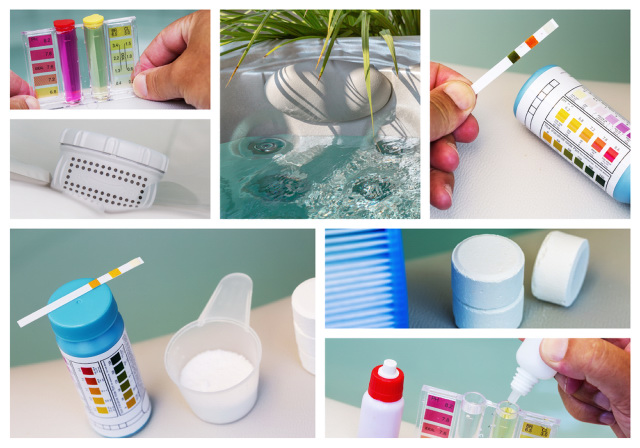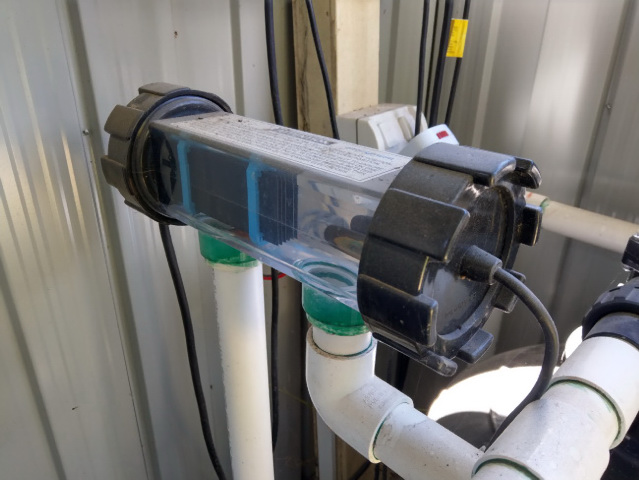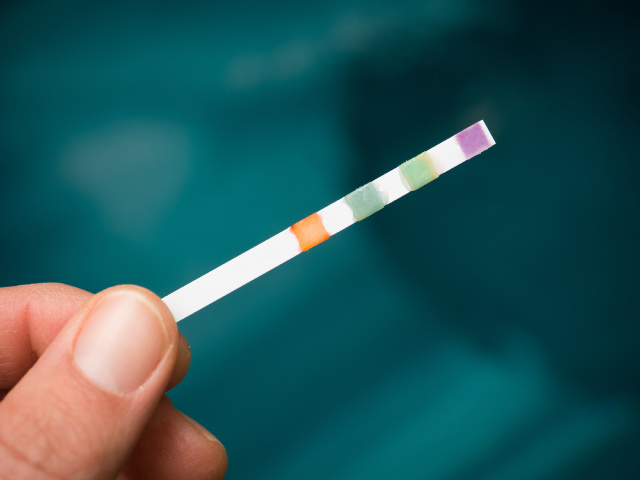Maybe you’re brand new to hot tubs or need to refill yours. Or perhaps you’ve bought a new hot tub and can’t remember what chemicals you need and when to need them. Luckily, we’ve got you covered!
So, in what order should you add chemicals to a new hot tub?
The correct order to add hot tub chemicals to a new tub is:
- Alkalinity balancers – Baking soda or sodium bisulfate
- pH adjusters – Soda ash or sodium bisulfate
- Calcium increaser (calcium chloride)
- Sanitizer (chlorine/bromine) and stabilizer (cyanuric acid – outdoor chlorine tubs only)
Adding hot tub chemicals (and the order to do so) can seem like a chore but keep reading to find out the best tips and tricks for maintaining a crystal clear spa.

Article Contents
What Hot Tub Start-Up Chemicals Do You Need?
There are five essential hot tub chemicals you need to add during start-up.
- Baking Soda – raises alkalinity. Slightly raises pH
- Soda Ash – raises pH in large steps. Slightly raises alkalinity.
- Sodium Bisulfate or muriatic acid – lowers alkalinity and pH
- Calcium Chloride – to raise calcium hardness levels
- Chlorine or Bromine – sanitizer to kill bacteria
Remember, before you start blindly adding chemicals, you’ll need to test your hot tub water first using a test kit or test strips.
1. Alkalinity Balancers
The ideal alkalinity level of your hot tub is 100-150 ppm. Alkalinity acts as a pH buffer, so balancing it before pH is crucial. Having an alkalinity increaser on hand will help correct acidic water (alkalinity is too low) and stabilize the pH.
You can use baking soda to increase the alkalinity:
- No additives or preservatives
- pH buffer in swimming pools
- Increases alkalinity & pH
To right the balance between alkalinity and pH, check out our guide, How to Raise Alkalinity in Hot Tub (Alkalinity is Low), for the best tips.
Unfortunately, there are no alkalinity decreasers, so you’ll need a pH decreaser which will lower both alkalinity and pH. Sodium bisulfate is best for hot tubs. You can also use muriatic acid.
2. pH Adjusters
Once you have the alkalinity level within its ideal range, you can now turn your attention to achieving the correct pH level (7.4 – 7.6). Again, use a pH increaser if the pH is too low (too basic) and a pH decreaser if the level is too high (too acidic). You can get a pH increaser here:
- Increases total alkalinity in pools and spas
- Granulated powder/fast dissolving
- Sodium carbonate
Use soda ash or baking soda to increase the pH. To decrease, use sodium bisulfate or muriatic acid.
Be mindful that adjusting pH levels tends to influence the alkalinity level.
3. Calcium Hardness
Calcium hardness measures the concentration of calcium in the water. It’s ideal to keep it slightly on the high side. If the calcium hardness level is too high, you’ll need to partially drain and refill the hot tub.
However, if the calcium hardness is too low, having calcium chloride close by (calcium increaser) will help normalize the level.
4. Sanitizer
There are several sanitizer options to choose from depending on preference and hot tub type.
Chlorine
Chlorine is the most common sanitizer across pools and hot tubs. It’s cost-effective, easy to use, and an aggressive algae killer. However, the smell of chlorine can be off-putting. And, it will need an accompanying stabilizer if your hot tub is outdoor to prevent the chlorine from burning off.
Bromine
Bromine is the second most common sanitizer. It is more expensive than chlorine but doesn’t interfere with pH much. Plus, it’s gentler on the skin and doesn’t give off a smell.
However, although bromine lasts longer, it takes longer to work. And, if your hot tub is outdoors, it will burn off quickly as bromine has no stabilizing partner chemicals (chlorine and cyanuric acid).
Biguanide
Biguanide is a non-chlorine sanitizer that is as effective at killing algae and bacteria as chlorine or bromine. Therefore, you don’t need to apply it as often as chlorine or bromine, which is gentler on the skin. However, it can deteriorate the rubber components of the hot tub and is more expensive than chlorine sanitizers.
Mineral Sanitizer
A hot tub sanitizer is a great sanitizer, using either silver (bactericide) or copper (algaecide) or a combination of both to sanitize. However, with this sanitizer, you’ll still need chlorine to effectively clean your tub, just not as much (less chance of chlorine smell).
Saltwater System
In the case of saltwater hot tubs, you don’t need to add any sanitizer during start-up. The salt in the water goes through electrolysis to separate into sodium and chloride ions. This free chlorine sanitizes the pool before re-combining with the salt, recycling through the filter.

5. Stabilizer
Stabilizer (cyanuric acid) is a crucial chemical for outdoor chlorine hot tubs. Without a stabilizer, chlorine is vulnerable to burning off from the sun’s rays. Therefore, non-chlorine spas don’t require a stabilizer.
Adding a stabilizer to your outdoor chlorine spa is essential for keeping the chlorine level in its optimal range.
If you’re unsure whether your hot tub needs cyanuric acid, check out our guide here: Do Hot Tubs Need Stabilizer? | How to Use Stabilizer
How to Add Hot Tub Startup Chemicals
Here are the order and detailed steps below to correctly add your chemicals to ensure you have a pristine spa to relax.
1. Test The Water

Before beginning anything, make sure to test the water using a spa chemistry test kit to get a baseline measurement of all chemicals. While you wait for the results, get the chemicals ready to go and take note of the spa water capacity.
JNW Direct chemistry test strips are a highly rated pool and spa chemistry kit.
- Suit pools and spas
- Tests 7 things including chlorine, bromine, pH, cyanuric acid
- Quick & easy to use
2. Adjust Alkalinity
Your test strip should tell you the current alkalinity level. You need to adjust it within 80-120 ppm.
- To increase alkalinity, you can add sodium bicarbonate (baking soda). If you need a thorough step-by-step, check out our guide How to Raise Alkalinity in Hot Tub (Alkalinity is Low)
- To decrease alkalinity, you can add muriatic acid or sodium bisulfate.
3. Balance pH Level
Once you’re happy with the alkalinity level, you can address the pH level (ideal range 7.4-7.6). Again, it’s essential to correct alkalinity first as it acts as a pH buffer. If the pH levels are off, they can lower chlorine effectiveness, irritate swimmers, or even erode spa equipment.
It might be worth retesting the pH level after correcting it as alkalinity influences pH.
- To lower the pH, add sodium bisulfate or muriatic acid. If you’re not sure which chemical to use, check out our detailed guide, How to Lower pH in Hot Tub (pH is Too High)
- If you want to raise the pH, add baking soda (sodium bicarbonate) for small adjustments or soda ash for larger adjustments.
Baking soda mainly increases alkalinity while soda ash has less effect on alkalinity, but you can check out our guide, 2 Ways to Raise pH in Hot Tub (pH is Low), to choose what’s best for you.
4. Correct Calcium Hardness
The ideal range for calcium hardness in hot tubs is 75-150 ppm. With hot tubs, it’s better to have the level on the slightly higher side.
- To decrease calcium hardness, it’s best to partially drain and refill the hot tub. And make sure to brush down the sides to remove any deposits. You might need to use a water filter whilst filling your hot tub if you have hard water (water high in calcium and minerals.
- To increase the calcium level, you can add calcium chloride. But make sure you follow the product instructions for your spa’s size.
5. Add Stabilizer If Needed
Adding a stabilizer, most commonly cyanuric acid, is critical for chlorine hot tubs that are outdoors. The stabilizer enables the chlorine to stay in the pool and keep doing its sanitizing job.
Keep in mind that some chlorine sanitizers, such as dichlor, already have stabilizers in them. So it’s not necessary to add it separately.
The ideal range for a stabilizer is between 30-50 ppm.
6. Add Sanitizer
The final step to starting up your hot tub is adding your chosen sanitizer. Before adding, make sure your alkalinity, pH, calcium hardness, and stabilizer levels are correct.
Each sanitizer’s dosage and application will vary, so it’s vital to follow the manufacturer’s instructions. This is particularly important with chlorine-containing sanitizers.
When To Add Shock
There is no need to shock your spa upon start-up. However, shocking your hot tub weekly is common practice for spa maintenance or when you have algae bloom or cloudy water. If you’re curious about how to shock your hot tub or when you’d need to, check out our guide, How to Shock a Hot Tub.
Can You Add All of Your Hot Tub Chemicals at Once?
You should never add all hot tub chemicals at once as this can cause a dangerous chemical explosion. You mustn’t mix chemicals before application either.
Aside from a potential explosion, adding chemicals all at once will drastically affect each chemical concentration level making it very difficult to achieve the correct balance.
Therefore, requiring you to have even more chemicals to correct the levels. Here they are:
- Alkalinity – 80-120 ppm
- Calcium Hardness – 75-150 ppm
- pH – 7.4-7.6
- Chlorine/Bromine – 3-5 ppm
What Temperature Should Hot Tub Be Before Adding Chemicals?
Ensure your hot tub reads a temperature of 80°F (27°C) before adding chemicals. This heat will help each chemical to dissolve into the water.
How Soon Can You Use Hot Tub After Adding Chemicals?
Experts recommend waiting at least 6 hours, ideally overnight, before using your hot tub. This is to ensure that the spa fully circulates the chemicals, particularly chlorine or bromine.
You’ll want to test your water first before using it. The correct levels are:
- Alkalinity – 80-120 ppm
- Calcium Hardness – 75-150 ppm
- pH – 7.4-7.6
- Chlorine/Bromine – 3-5 ppm
Final Thoughts
You must respect any chemical you come into contact with. So, knowing the correct order to apply your hot tub chemicals is vital to keep yourself safe while achieving a perfectly balanced spa.
Luckily, upkeeping your hot tub will become second nature once you know the order.




